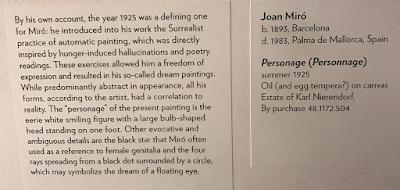Continuing on my journey of discovering inspirational and creative spaces, I ventured to The Guggenheim, a staple of the New York City art scene since its opening in 1959. Not only is the architecture of this building stunning, the interior aestheticism will take you for a spin (literally).
Upon entering this beautiful behemoth of spiraling gallery space, museum goers are escorted into an elevator and taken up to the sixth floor in order to begin their descent down each floor of exhibitions. The unique architecture of the space is an experience in itself, the unconventional rotunda design provides visitors a fluid sense of interacting with the contemporary collections in a way that feels more personal. As I began working my way down each floor I couldn't help but notice the amount of young artists that stood along the sidelines, sketchbook and pencil in hand, consumed with the artwork in front of them in attempt to find inspiration in the work of the greats. Frank Lloyd Wright, the architect behind the art museum, sought to elevate and enhance the human experience through his designs and I must say he succeeded.
 |
| Vision by Alphonse Osbert |
 |
| The Death of Orpheus by Jean Delville |
 |
| Personage by Joan Miró |
Take Miró for example in the above description of his creative process, without reading the description how could one understand the process behind the abstract Personage painting? Now I'm not saying that every artist has to go through a hunger-induced hallucination to create art, but there is beauty in such madness.
The Guggenheim as an entirety opened my mind to the experience of a space and the impact that has on perception, from the architecture to the pragmatic placement of each piece of work the space speaks to the creative process. After leaving the museum, my interest in the uniqueness of the experience left me with a thirst for wanting to know more in how it all came together. So of course, as any millennial would, I took to my right-hand man Google and it all started to make sense in why the nonsense felt so right. In an excerpt from an article about the museum's architect, Frank Lloyd Wright and his creative process;
Keep it creative xx
The Guggenheim as an entirety opened my mind to the experience of a space and the impact that has on perception, from the architecture to the pragmatic placement of each piece of work the space speaks to the creative process. After leaving the museum, my interest in the uniqueness of the experience left me with a thirst for wanting to know more in how it all came together. So of course, as any millennial would, I took to my right-hand man Google and it all started to make sense in why the nonsense felt so right. In an excerpt from an article about the museum's architect, Frank Lloyd Wright and his creative process;
Good architecture, Wright wrote in a 1908 essay, should promote the democratic ideal of "the highest possible expression of the individual as a unit not inconsistent with a harmonious whole." That vision animates the Guggenheim Museum. In the course of descending the building's spiral ramp, a visitor can focus on works of art without losing awareness of other museumgoers above and below. To that bifocal consciousness, the Guggenheim adds a novel element: a sense of passing time. "The strange thing about the ramp—I always feel I am in a space-time continuum, because I see where I've been and where I'm going," says Bruce Brooks Pfeiffer, director of the Frank Lloyd Wright Archives in Scottsdale, Arizona.Every moment of my time within this space made me feel as though I were taken into another realm, one that allowed a pure and personal experience of interacting with art, yet also a very conscious collective experience of existing within the space itself.
Keep it creative xx
P. S.



No comments:
Post a Comment